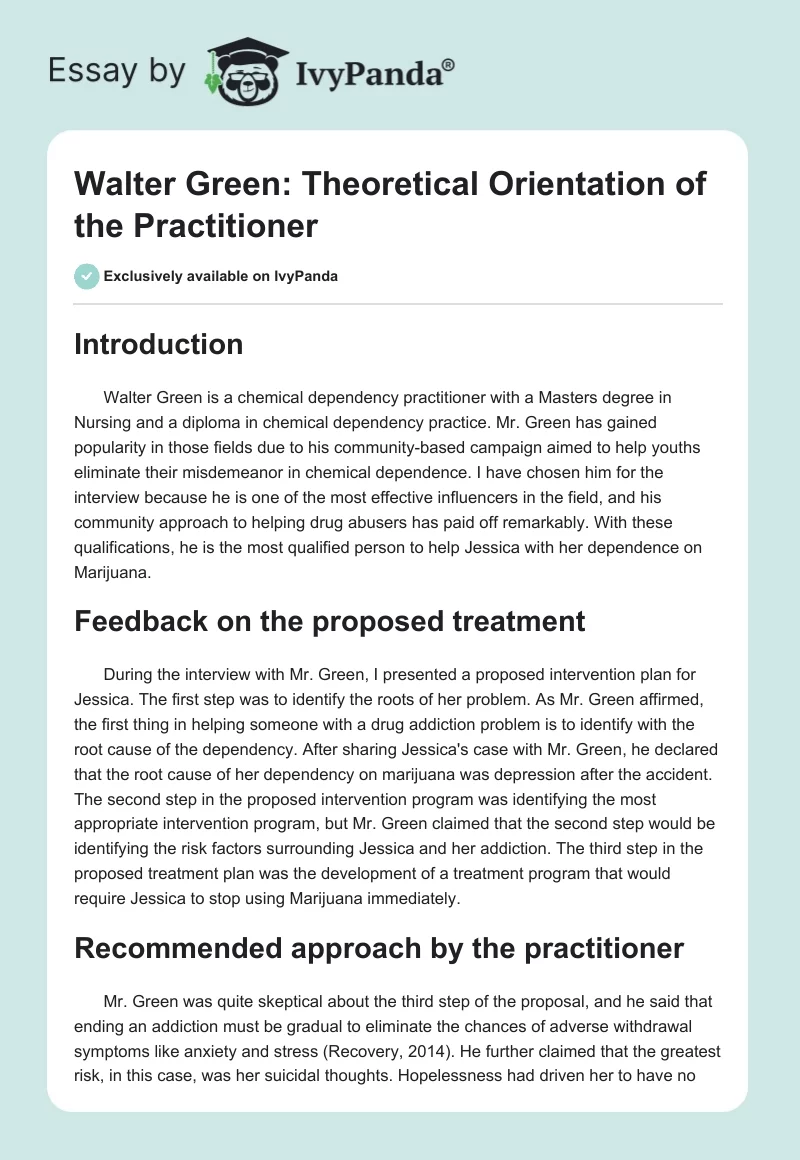Introduction
Walter Green is a chemical dependency practitioner with a Masters degree in Nursing and a diploma in chemical dependency practice. Mr. Green has gained popularity in those fields due to his community-based campaign aimed to help youths eliminate their misdemeanor in chemical dependence. I have chosen him for the interview because he is one of the most effective influencers in the field, and his community approach to helping drug abusers has paid off remarkably. With these qualifications, he is the most qualified person to help Jessica with her dependence on Marijuana.
Feedback on the proposed treatment
During the interview with Mr. Green, I presented a proposed intervention plan for Jessica. The first step was to identify the roots of her problem. As Mr. Green affirmed, the first thing in helping someone with a drug addiction problem is to identify with the root cause of the dependency. After sharing Jessica’s case with Mr. Green, he declared that the root cause of her dependency on marijuana was depression after the accident. The second step in the proposed intervention program was identifying the most appropriate intervention program, but Mr. Green claimed that the second step would be identifying the risk factors surrounding Jessica and her addiction. The third step in the proposed treatment plan was the development of a treatment program that would require Jessica to stop using Marijuana immediately.
Recommended approach by the practitioner
Mr. Green was quite skeptical about the third step of the proposal, and he said that ending an addiction must be gradual to eliminate the chances of adverse withdrawal symptoms like anxiety and stress (Recovery, 2014). He further claimed that the greatest risk, in this case, was her suicidal thoughts. Hopelessness had driven her to have no purpose in life. Mr. Green said that eliminating these risks will be the first priority of his intervention program (Litt, Kadden & Petry, 2013). He also emphasized involving Jessica’s family in a treatment plan that would run for three months.
Mr. Green also asserted that she would not need to be confined to a rehabilitation center in order to allow her to continue with her daily life activities. His proposed program involved the gradual reduction of her intake of marijuana, which would end in a month. This will be followed by daily attendance to a support group pioneered by Mr. Green. She will also need to visit Mr. Green every Saturday afternoon for counseling and evaluation of withdrawal symptoms. Mr. Green was also keen to highlight that the most important aspect of treating Jessica was to drive her into accepting her physical situation. Jessica needs to come to terms with her disability and have the motivation to move on. This process will have to be executed through the support of her family. Her parents and children will have to help her with her challenging daily activities to make life simpler for Jessica.
Community resources commonly accessed by the practitioner
Mr. Green has traditionally used community members as the main resources to help the chemical dependency victims. He has developed several community help groups for various substance abusers to attend during their rehabilitation process.
Each community help group has a trained professional delegated with the task of offering advice to the members. The groups have seen the development of a better community where substance addicts rejuvenated hope of getting back to their normal states of wellness.
References
Litt, M. D., Kadden, R. M., & Petry, N. M. (2013). Behavioral treatment for marijuana dependence: randomized trial of contingency management and self-efficacy enhancement. Addictive behaviors, 38(3), 1764-1775.
Recovery: Find the best residential marijuana recovery center. (2014). Web.


